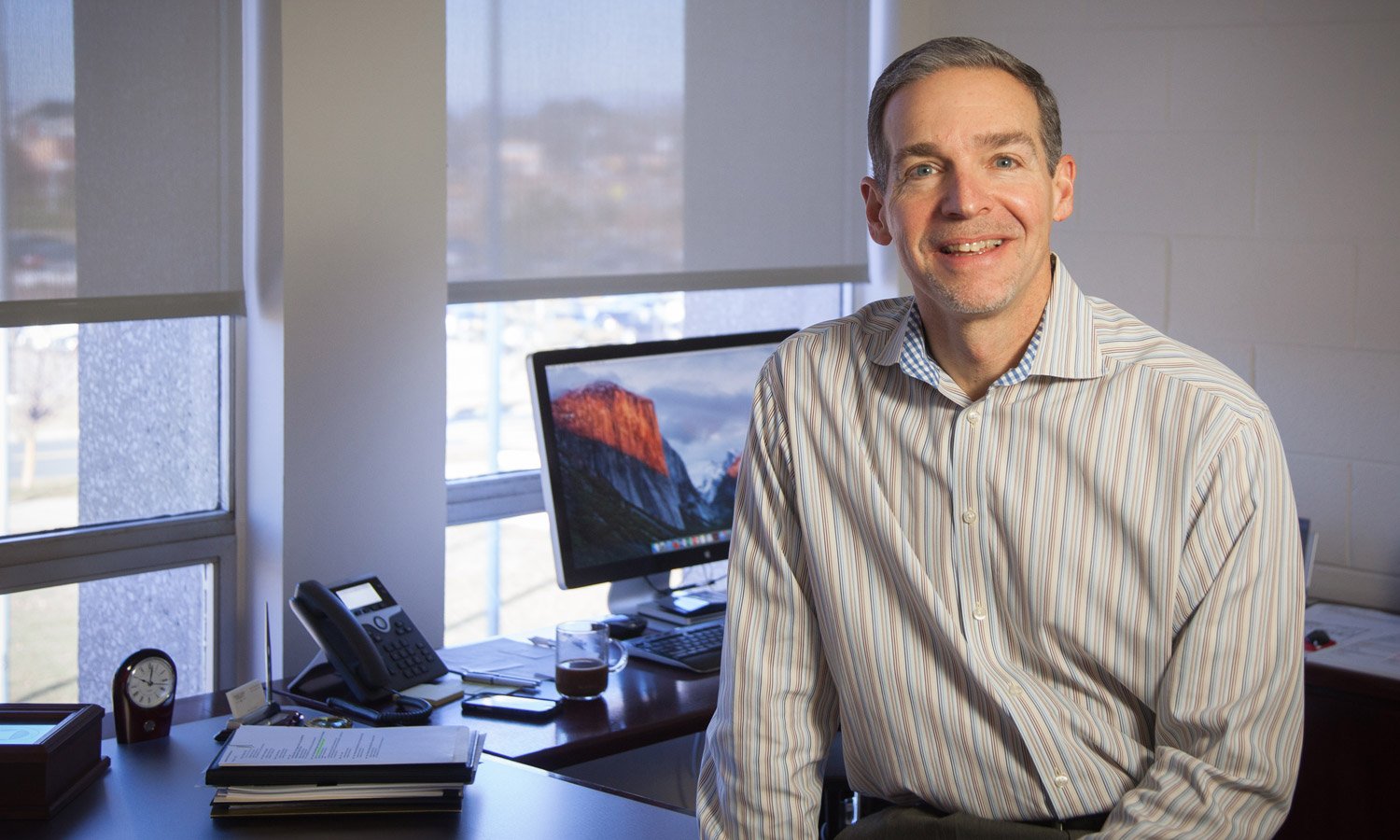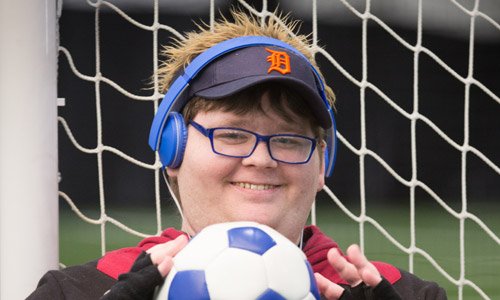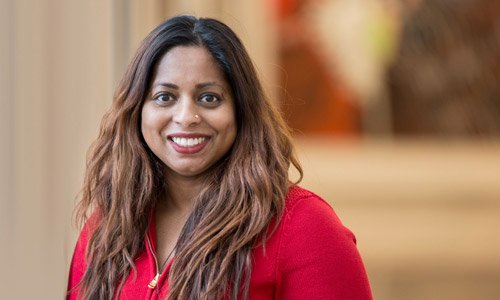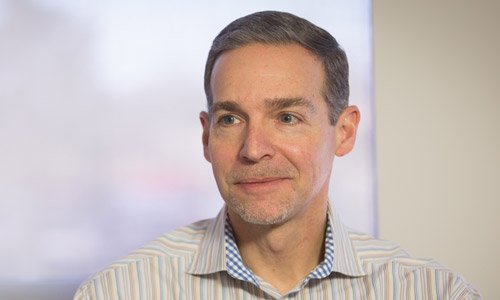Features
Features
Winter 2016
An Interview with Oakland Chief Operating Officer Scott Kunselman
 |
| “My fundamental objective as a manager my whole career is to ultimately make sure that the team in place is stronger than me and knows what to do on a daily basis.” |
In December, Scott Kunselman joined Oakland as its first chief operating officer. The mechanical engineer who relaxes by climbing and hiking Yosemite’s 60-foot granite walls, skiing and splitting firewood, is ‘discovering the magic’ of a second career.
Q: You worked at Chrysler for more than 30 years. What is it like to work at the former home of John Dodge?
A: I am a closet architect ― I love architecture, buildings, history. OU personifies all those things: the piece of history, the architecture opportunities with building, and the capital opportunities. There is all this opportunity for OU to really achieve its premium position, a lot of it through capital improvements that I can’t wait to be part of.
My youngest son is helping me restore a 1964 Dodge truck. A friend is helping me in a shop, welding new floor pans because the floors had rusted out, pretty common with these Dodges. My son is a great sander; I can hand him a part and a sanding sponge and have it come back with no paint on it. I can’t wait to get a photo of the truck and my son at Meadow Brook Hall.
Q: What was growing up like? Who influenced you?
A: I grew up in western Pennsylvania about an hour north of Pittsburgh in between the towns of Butler and Kittanning, somewhat rural. I was the oldest of three boys and got a lot of attention from my father. My father had a large influence on me. He was a high school metal shop teacher and a teen during the ’50s golden age of car clubs and hot-rodding. This passion continued into my childhood and he went through vehicles quickly, so I got a lot of hands-on time from an early age.
I ended up going to Carnegie Mellon in Pittsburgh as a mechanical engineering major. My math and science interest and capabilities stood out when I took standardized tests, so that seemed like the logical career. Going into engineering school, it wasn't in my concept to go work on cars. Once I saw the interest was there on the automotive, we re-established the SAE Chapter. I did an SAE mini-formula car.
Chrysler had just come out of its trying times with Iacocca and the loan guarantees in the early ’80s and they started to hire again. I was a junior, and for the first time Chrysler recruiters had come on campus to recruit full time. I patched them a resume and ended up getting a summer job.
I had never been to Detroit. I came up here for the summer and lived at Lawrence Tech in the dorm on the south side of Ten Mile where the big radio tower is, and got to watch the lightning jump between all the turnbuckles there. Of course, this was in the days when the 696 didn’t go through town. I considered Farmington Hills to be the boondocks.
After that experience, I was hooked. I joined Chrysler as a full-time employee in 1985 and was in a rotation program for engineers for training and ended up going back to school to get an M.S. in Engineering and later an MBA while I worked there. I got to do everything I ever would have imagined.
Q: You were a part of many Chryslers.
A: I went through at least five different cultures: The original Chrysler. Then Chrysler bought AMC and engineering changed because Francois Castaing (also with ties to Renault) came over as head of Engineering and formed a very customer-focused platform team structure.
Next, we partnered with Daimler, which was probably more fun for the engineers than the brand teams. Later, we were owned by Cerberus. That was one of the ones that we don’t like to remember. I was working at Plymouth Road on new trucks that were complex enough that I more or less got to do what I wanted.
The partnership with Fiat was great, the most integrated they ever actually achieved. The Marchionne style of leadership of being engaged and eliminating hierarchy and empowering was liberating. That brought the company to a new level.
Q: Who have been your mentors?
A: I had several. Under the Castaing platform base, John Miller was one of my early mentors. He and Mike Mazzeo ran the Executive MBA program at Michigan State, and now they work at OU’s School of Business Administration.
I really looked to other leaders within and outside of Engineering through my career to being more a part of the business. The most recent six years coming out of bankruptcy, being given the job as Head of Engineering and basically told to restructure, I had the chance to do things.
Q: You hired the 2,000 people.
A: I hired the 2,000 people. Restructured the group. Then took over Purchasing, so I had a commercial job, a chance to get to know and spend time with the suppliers in the area.
Q: What drew you to OU?
A: A combination of things. My entire career I always anticipated that I wanted to do something very different. I didn't know how that would occur. Logically, you think, ‘I'll retire and then I'll do my something different and it'll probably be volunteering. I'll want to go to the National Parks and build trails or something like this.’
When this opportunity came up, I said, ‘this is the thing. It’s here now and it manifests itself in a kind of second career state.’ It was thrilling to have the opportunity to join the Board and get exposure to this place and discover the magic.
Oakland is blessed with a gorgeous, big piece of property and is kind of limitless in terms of boundaries for expansion. The campus has undergone incredible upgrades recently. I can feel it through some of the alumni who were never engaged before and who now have this swelling of pride that they just see from the improvements on the campus. They want to re-engage.
Q: Describe what your job has entailed so far.
A: My role is operations. In the fundamental concept of the University, it’s a support, a service, a source to make the place run. I’ve been getting to know the people and what they do so that I can better be of service. I'm trying to do a complete cross-section from the administration to the students. My goal is to understand the roadblocks that people experience on the service side of the business. So far, I'm hearing that better means faster, fewer impediments.
Q: How would you describe your management style?
A: I don't know that I've been asked to describe it. The number one thing I view as critical is empowerment. My fundamental objective as a manager my whole career is to ultimately make sure that the team in place is stronger than me and knows what to do on a daily basis. That I don't get in their way, and to remove their roadblocks.
When you become a supervisor or a manager, there's always a time when you think that you get to make all the decisions. That’s not how I do things as a leader. You’re not the decision maker ― you’re an enabler.
I don’t differentiate myself from the hierarchy. I’m just an employee like everyone else here, trying to do my job, so I don’t want any barriers for that. My goal would be to fit in as best as possible. That I’ll try not to wear ties as much as possible.
Eliminating hierarchies helps with speed. If the managers can remove the roadblocks, we can operate faster. Faster is the best form of efficiency.
When people in operations use the word ‘efficiency,’ you think ‘Oh, my gosh! He's going to come here and try to chop costs out of that equation.’ While I’m sure there are opportunities for that in some cases, the more natural thing is to look to speed things up. Speed is a more natural giver of efficiency, and one that I think is readily accepted because it produces two types of results ― both quicker to your end game and also naturally at lower cost.
Dr. Hynd and I have, let’s say, almost opposite backgrounds ― his spending so much time in higher ed on the academic side and my spending most of my time in the corporate world on the industrial side. We have an opportunity to learn and meld those two learnings into something that I think Oakland can really benefit from.
Q: We run pretty lean at OU.
A: Exactly. I hope to put some definition around that. I’m very accustomed to using metrics to define things. What I'll try to drive a little bit for is to always know where we are competitively. It might be great that we grow or improve by 10 percent, but benchmarking ourselves is not always the best method. Being able to put everything in a comparative perspective will help us make the best decisions. At the same time, we need to look at capacity. It can be anything: Do we have enough classrooms? Do we have enough faculty? Two things you wouldn’t initially think of.
Q: There’s the matter of how we want to define ourselves.
A: It’s appropriate to set lofty sights, but in a time frame that makes sense. If you think about what’s happening from the recently defined strategies and what’s coming to fruition with the campus master planning process, you’ll logically see us derive even more specific goals that are say, ‘In the future we perceive ourselves to be ...’
The type of objectives I call ‘destination state’ are here to help align direction, not necessarily to an achievement by the end of the year. The last thing we want is people pulling in opposite directions. So, having these destination-type objectives for the campus is appropriate to help align direction for all of our metrics. I hope we will use aspirational benchmarking to help pick what they should be.
Q: In terms of the students that we educate: How should OU shape them to go out into the world? What should they leave here with?
A: Inherently, I believe the concept is teaching them how to think. Not to leave here with a new factoid in your head ― you can get that anywhere. Knowing how to use them is what’s important, knowing how to think and how to react. To me, it’s everything from learning how to deal with people ― because that’s what you still largely interface with ― to knowing how to pursue your subject matter from a methodology perspective. It’s knowing how to think so that you can react and be a part of the change and innovation that’s going to occur. Everyone has a chance to be an innovator and an entrepreneur.
Q: Your wife, she is a Pioneer.
A: Yes. Denise graduated from the School of Business Administration in 1986.
Q: What are some of your hobbies?
A: Pretty much everything ― I enjoy so many things that I can't get good at them. Being outdoors: backpacking, hiking, fishing, hunting, skiing, mountain-biking, snowshoeing, cross-country skiing. These naturally come from growing up in a rural setting, spending a lot of time outdoors with my father and working in an industry where you naturally spend a lot of time indoors.
For good or bad reasons, I grew up in a house that had a very large fireplace and we burned through firewood like there was no tomorrow. I got very good at splitting firewood at a young age.
When you work on projects with three- to four-year timelines, it was always rewarding to go build a rock wall or split some firewood, because I had instant results. Oh, I love that stuff!
Yosemite is so far my favorite national park. The best is its 17-mile round trip to the top of Half Dome, with a mile of gain. I’m pretty adventurous, but the last 600 feet is 60 degrees up sheer granite, with cables and boards every 40 feet, so you’ve got to hang on ― a bit intimidating in heights and endurance. It’s basically like climbing stairs for 17 miles.


